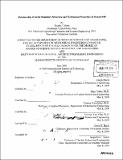Relationship of grain boundary structure and mechanical properties of Inconel 690
Author(s)
Marra, Joseph J
DownloadFull printable version (17.84Mb)
Other Contributors
Massachusetts Institute of Technology. Dept. of Mechanical Engineering.
Advisor
Bilge Yildiz.
Terms of use
Metadata
Show full item recordAbstract
Stress corrosion cracking (SCC), failure due to environmentally assisted crack nucleation and propagation, is an important metallurgical problem with impact on current and future designs of ship structural components and nuclear reactors. SCC occurs in the presence of tensile stress, corrosive environment, and a material with susceptibility. The initiation of SCC is difficult to detect and control due to the highly localized nature of chemical and mechanical conditions. As a result, its inhibition has been a particularly challenging problem. SCC mechanism is dependent on the microstructure, particularly the grain boundaries, for a given alloy composition. Therefore, inhibition could be sought from an improved fundamental understanding of the structural and mechanical characteristics at the material's grain boundaries. This thesis investigated the relationship between the structural nature and the nanoscale mechanical properties on and near the grain boundaries to identify their role in the resistance to stress corrosion cracking. Inconel 690, an austenitic Ni-alloy, was chosen as the material of interest for its relevance in current applications in the nuclear energy technology. An integrated approach to probe the structural, mechanical and chemical information at the nanoscale consistently at select grain boundaries was developed. Grain boundary engineering was accomplished on Inconel 690 through thermomechanical processing (TMP) to produce samples with a desirable distribution of grain boundary structures. Crystallographic structure of the boundaries was identified using electron backscatter diffraction and orientation image mapping. Nanoindentation at ambient conditions was performed to extract mechanical properties with high spatial resolution at and near the selected grain boundaries. Inherent and tip-induced mechanical properties of grain boundaries were characterized on the solution annealed Inconel 690. Mechanical properties governed by the presence of chromium carbide precipitates at the boundaries were characterized on the TMP Inconel 690. Hardness measured on and near the [sigma]3, low angle, and high angle grain boundaries of the TMP Inconel 690 revealed the distribution of chromium carbide precipitates at each respective grain boundary. Chromium carbide precipitates led to continuously high hardness on the [sigma]3 grain boundaries and discontinuous with large variations in the hardness on low and high angle grain boundaries. These results are consistent with the higher relative cracking susceptibility for low and high angle grain boundaries relative to [sigma]3 grain boundaries. Inherent hardness of the solution annealed Inconel 690 were found to be the same for both the grain boundary and bulk regions, and did not vary with grain boundary type, specifically the [sigma]3 and high angle boundaries. (cont.) This finding is attributed to the weak dependence of the dislocation mobility on the diffusion path during high temperature annealing of the sample, which resulted in an approximately uniform distribution of dislocations prior to nanoindentation. On the other hand, greater hardness was induced at the grain boundaries due to the pile-up of dislocations created by the indentations towards the grain boundaries. The relative increase in hardness induced by the indentations, and the spatial extent of this increase were found to be equivalent for different grain boundary types. These results indicate comparable ease of dislocation mobility and absorption at the different grain boundaries of Inconel 690 when indented at room temperature.
Description
Thesis (S.M.)--Massachusetts Institute of Technology, Dept. of Nuclear Science and Engineering; and, (S.M. in Naval Architecture and Marine Engineering)--Massachusetts Institute of Technology, Dept. of Mechanical Engineering, 2009. Cataloged from PDF version of thesis. Includes bibliographical references (p. 138-139).
Date issued
2009Department
Massachusetts Institute of Technology. Department of Mechanical Engineering; Massachusetts Institute of Technology. Department of Nuclear Science and EngineeringPublisher
Massachusetts Institute of Technology
Keywords
Nuclear Science and Engineering., Mechanical Engineering.